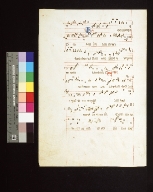|
REFINE
Browse All : Music - Manuscripts - Illustrations and Gregorian chants - Illustrations by Ege, Otto F. of Italy
1-2 of 2
Title
Graduale: fragment
Creator
Catholic Church
Summary
[Ms. This manuscript leaf is part of a collection of medieval manuscript leaves selected to illustrate the art of the manuscript during the period of its greatest development and influence. They have been taken from books written in various European scriptoria by Benedictine, Franciscan, Carthusian, Dominican, and other orders of monks. Many are enriched with handsome borders, initial letters, and line-endings rendered in color. Twenty-five are illuminated with burnished gold or silver. The texts include the Bible, various church service books, the writings of the Church fathers, and some of the Classics., In rotunda gothic script, A Gradual contains the appropriate antiphons of a mass sung by the choir of the Latin Church on Sundays and special holidays. The text was furnished largely by the 150 Psalms and the Canticles of the Old and New Testaments. The superb example of calligraphy in this leaf illustrates the supremacy of the Italian scribes of the time over those of the rest of Europe. It is frequently assumed that this late revival of fine writing may have been caused by the concern of scribes over the impending competition with the newly invented art of printing. The music staff still retains here the early 12th century form with the C-line colored yellow and the F-line red. The four-line red staff had been in use for over two centuries before this manuscript was written. This leaf was created in Italy.]
Title
Missale: fragment
Creator
Catholic Church
Summary
[Ms. This manuscript leaf is part of a collection of medieval manuscript leaves selected to illustrate the art of the manuscript during the period of its greatest development and influence. They have been taken from books written in various European scriptoria by Benedictine, Franciscan, Carthusian, Dominican, and other orders of monks. Many are enriched with handsome borders, initial letters, and line-endings rendered in color. Twenty-five are illuminated with burnished gold or silver. The texts include the Bible, various church service books, the writings of the Church fathers, and some of the Classics., In angular gothic notation, The large-scale missal was intended to be viewed at a distance by a choir who shared it amongst themselves. It was much easier to write out one large book for multiple use than it was to write out a requisite number of individual copies. The delicate tracery in the initials shows how beautifully vellum functioned as a substrate for bookmaking. Its hard surface and residual fat content made it a perfect substrate for the water-based inks of the medieval scribes. The hair follicles of the calf from which this vellum was obtained still show clearly in this manuscript and were not at all considered a distraction or a flaw. This vellum leaf was created in Italy.]
1-2 of 2
|

